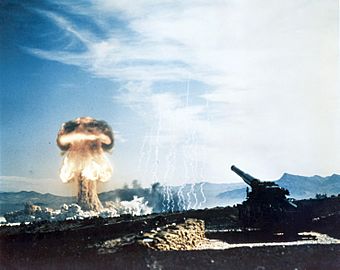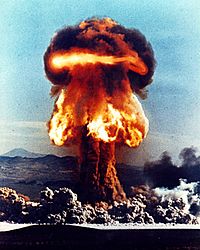Upshot-Knothole Grable facts for kids
Quick facts for kids Upshot–Knothole Grable |
|
|---|---|

The mushroom cloud from Upshot–Knothole Grable, with the cannon it was fired from in the foreground.
|
|
| Information | |
| Country | United States |
| Test series | Operation Upshot–Knothole |
| Test site | Nevada Test Site |
| Date | May 25, 1953 |
| Test type | Atmospheric |
| Yield | 15 kt |
| Navigation | |
| Previous test | Upshot-Knothole Harry |
| Next test | Upshot-Knothole Climax |

The Upshot–Knothole Grable was a special nuclear weapon test. It was carried out by the United States on May 25, 1953. This test was part of a larger series called Operation Upshot–Knothole.
The nuclear device exploded at 8:30 AM Pacific Time. This happened 19 seconds after it was launched. The test took place in Area 5 of the Nevada Test Site.
Contents
The Grable Nuclear Test
The name Grable was chosen because "G" stands for "gun." This was important because the bomb was fired from a large gun. It was a new type of nuclear weapon.
A Special Kind of Bomb
The Grable bomb was the first nuclear artillery shell ever fired. An artillery shell is a large bullet fired from a cannon. This test was the only time the U.S. tested such a shell.
Most nuclear bombs work by "implosion." This means they squeeze the nuclear material inward. But Grable was a "gun-type" weapon. It shot one piece of nuclear material into another. This caused the explosion.
Only four gun-type nuclear bombs have ever been exploded. The first was Little Boy, used on Hiroshima. Grable was the second. The last two were test bombs called W33.
The Atomic Cannon
The Grable shell was called a Mark 9 nuclear weapon. It was 280 mm (11 inches) wide and 1380 mm (54 inches) long. The bomb weighed 364 kg (803 pounds).
It was fired from a huge cannon called the M65 Atomic Cannon. This cannon weighed 77 metric tons (85 short tons). It could shoot the shell very fast, at 625 meters per second. This gave it a range of about 32 km (20 miles).
The Big Bang
The Grable bomb exploded 19 seconds after being fired. It detonated over 10 km (6.25 miles) away from the gun. This happened over a place called Frenchman Flat at the Nevada Test Site.
The explosion happened 160 meters (524 feet) above the ground. Its power was about 15 kilotons. This is similar to the power of the Little Boy bomb.
The explosion created a mushroom cloud. It also had a strange effect called a "precursor." This was a second shock wave that formed close to the ground. It caused more damage to things like jeeps and trucks. This made military leaders think differently about how to use nuclear bombs in battles.
Important People Present
Some important leaders watched the test. These included Admiral Arthur W. Radford. He was the top military advisor at the time. Secretary of Defense Charles E. Wilson was also there.
Misplaced Photos
Some pictures from the Grable test were later mixed up. They were accidentally labeled as belonging to a different test from 1957. Because of this, many official documents have the wrong photo labels.
See also
 In Spanish: Upshot-Knothole Grable para niños
In Spanish: Upshot-Knothole Grable para niños

